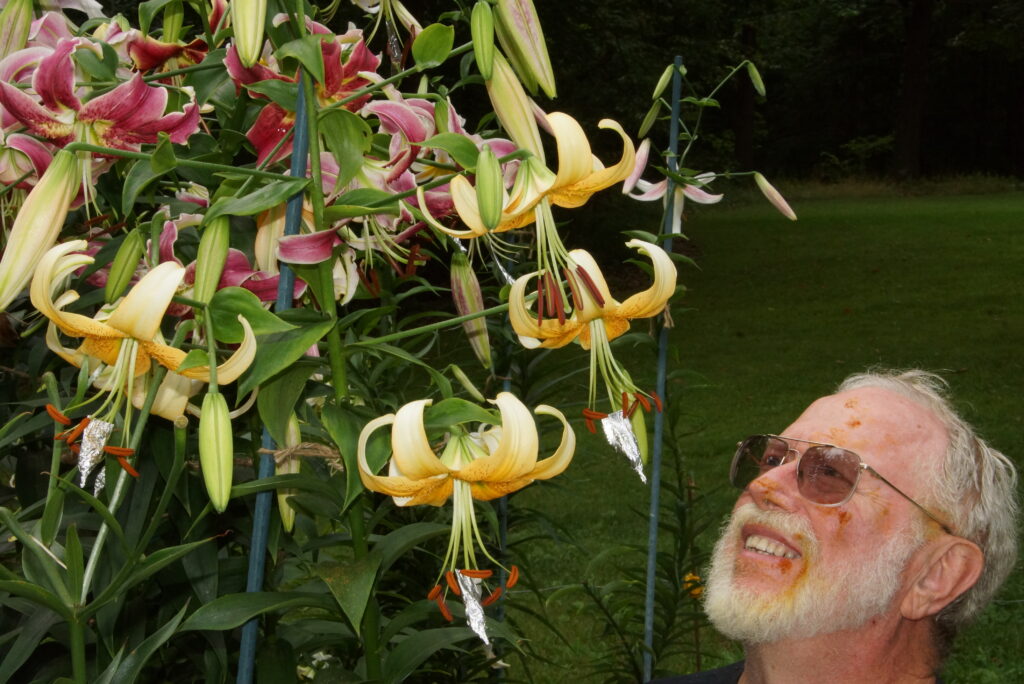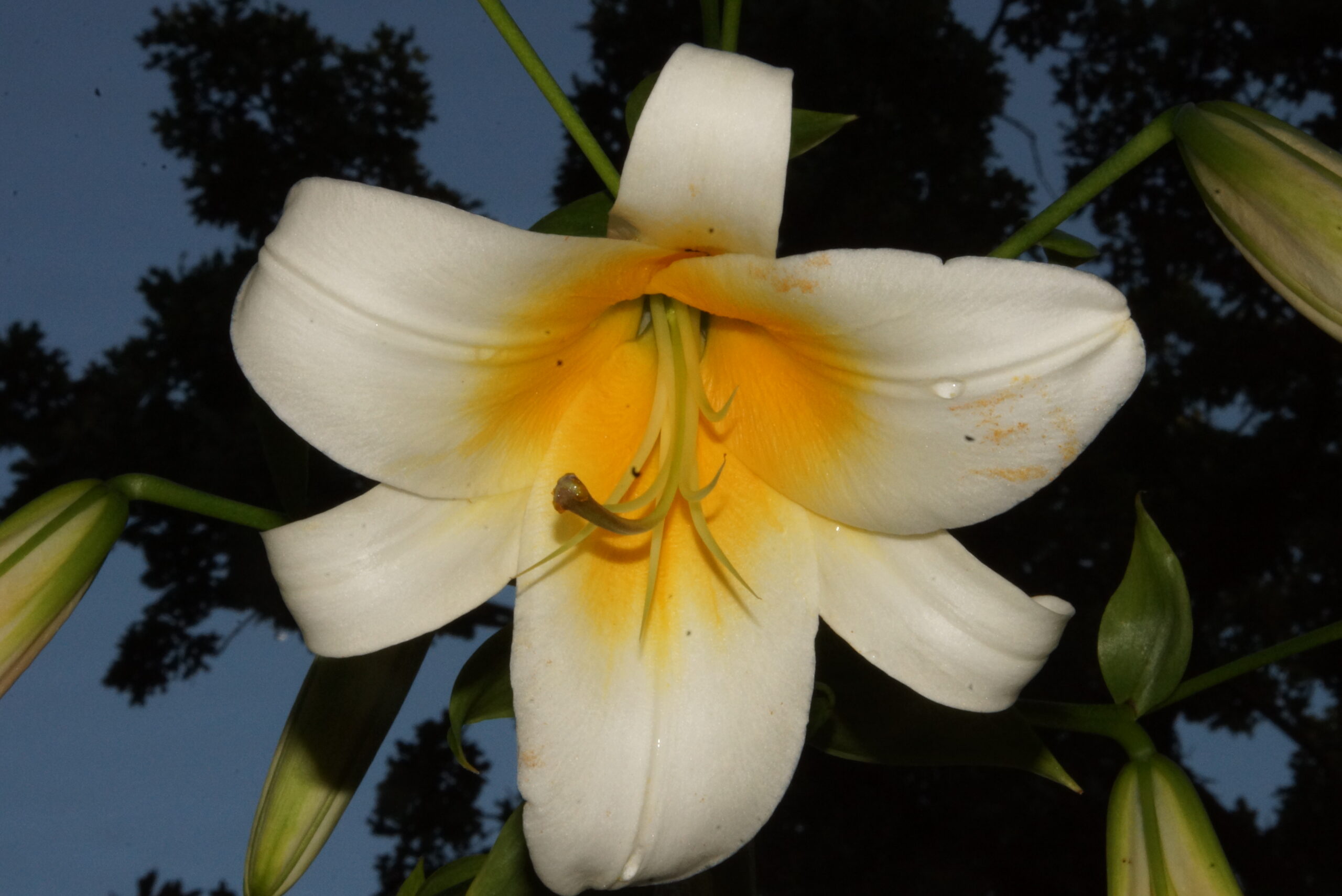by Arthur F. Evans
J

In the US lily fanciers mostly grow hybrids for two reasons. The first is that most species, including our own, are not easily pleased by the widely varying conditions in our suburban gardens. The second is that the great majority of the cultivars available to us have been the hybrid products of the cut flower industry.
Since the loss of Oregon Bulb Farms, many amateurs and small companies have tried to carry on with hybridizing programs which aimed to produce lilies which were widely adapted and disease tolerant. The North American Lily Society has stimulated interest in both hybridizing and the appreciation of the pure species through its seed exchange, educational programs, international shows, and affiliated regional lily societies. A new organization affiliated with NALS is the Species Lily Preservation Group. Its members are devoted to the culture, propagation, and dissemination of bulbs, pollens, and seed of the world’s Lilium species, with a keen interest in the rare ones. The collection is growing rapidly, and the plants are being propagated up on the volcanic slopes of Mt. Hood, near Portland ,Oregon. Our grower is Mr. Edward McRae, a native of Scotland, trained at Kew Gardens, and employed for many years as head hybridizer by Mr. Jan de Graaff at Oregon Bulb Farms. A most exciting development for species devotees is the recent availability of rare and even previously unknown species from China, the likely cradle of Lilium evolution. Mr. McRae is now growing seedlings from these recent Chinese imports, including L. rosthornii, L. bakerianum, L. taliense, L. amoenum, L. wardii, and L. speciosum var. gloriosoides, which will both delight the species purists and eventually benefit the hybrid gene pool as well.
Lily hybridizing in North America is done in the three main areas of the Northern US and the Southern parts of the Canadian Provinces from British Columbia to Ontario. Commercial production has been mostly along the Pacific coast, but there are many dedicated amateur hybridizers in the upper Midwest, centered in Minnesota, as well as the Northeast US from Maryland well into Ontario. Most of my hybridizing friends work with asiatics and aurelians, since these are generally adapted, somewhat disease tolerant, and fertile without the need for special techniques. Unlike cut flower types, our lilies can be any color, any season, any flower orientation. In short they can show any variations which please us, as long as they are vigorous, hardy perennials. North American amateurs are not trying to turn Lilium into Tulipa.
In the last 20 years, there has been great interest in the tetraploid asiatics because of their stronger stems and larger blooms. Tetras are also capable of producing much more variation among the seedlings in a single cross, an obvious advantage when one is looking for the charming novelty. Great progress has been made in this group and others because of the extensive cooperation between amateur hybridizers, and even with some commercial hybridizers. This has certainly been a great joy to me because some of my best friends have been those I met through hybridizing.
Here at Possum Holler, my greatest frustration was that I could not maintain the orientals. Most succumbed to our summer heat and warm-soil pathogens such as fusarium and rhizoctonia within a year or two. The Aurelians and Chinese trumpets are much more tolerant of our heat and clay soils, however. So, when I heard about the new group of hybrids with the somewhat unfortunate name “orienpets” which combined the orientals with the trumpets and aurelians, I sought out the pioneers who were doing this hybridizing. They were LeVern Freimann, Leslie Woodriff, Peter Schenk, Wilbert Ronald, Robert Griesbach, and Judith Freeman. These new hybrids are high performers in gardens from coast to coast, as evidenced by their domination of the annual Lily Popularity Poll conducted by the North American Lily Society. Most are large plants, often 2-2.5 M tall with 20-60 blooms which will stop traffic for several weeks in the summer season. ‘Scheherazade,’ ‘Northern Carillon/Silk Road,’ and ‘Leslie Woodriff’ are three of the best.
The best part is that in seedlings from this group I can select for intermediate and oriental type blooms on plants which show great vigor and dependability here in the sunny South. That is, if I can overcome the fertility problems, which are daunting. Fortunately, our 30-35C degree summer heat allows more embryos to form than a cooler climate might. Also, I’ve learned to do embryo culture at the kitchen table, which allows me to save embryos from crosses not possible otherwise. To expand the polyploid orienpet or “OT” gene pool, I convert diploid cultivars to tetraploids using colchicine or oryzalin. At home it is a slow and uncertain process, so I also send potential breeders to Iribov bv in the Netherlands to be converted.
My first orienpet crosses were based on the tetraploid form of Black Beauty (Lilium speciosum x Lilium henryi), perhaps the most widely adapted and “bombproof” lily known. It grows well almost everywhere. I wanted its vigor, adaptability, and disease resistance in my seedlings. It delivers all these qualities, but the speciosum red color is double dominant. You start getting clean non-red colors in the second outcross from tetra Black Beauty. Fortunately, even in the second outcross, it’s vigor is still evident, though disease resistance and adaptability will be influenced by the diluting parents of the F1 and later generations. Using Lilium auratum hybrids and Lilium rubellum hybrids in crosses with the Black Beauty seedlings gives beautiful forms and clear, true pinks, but greatly diminishes disease tolerance.
My next project was to cross the strongest orientals, such as ‘Jouney’s End’ and ‘Allegra’ onto my best aurelian trumpets. I got some very nice intermediate forms from these crosses which appear to be both heat and disease tolerant. Some are diploid, and some are triploid, which often happens for reasons I don’t understand, in wide crosses. Triploids pollinated by tetraploids may produce a few tetras and a few triploids. Most triploids are rather infertile.
Currently, my strategy is to work more tetra orientals into the orienpet hybrids while selecting for heat tolerance and disease tolerance. This will eventually fulfill the dream of combining the beauty of the orientals with the garden adaptability of the aurelians. This would create oriental type lilies which would thrive in the Southern half of the US, a significant increase in our potential market for garden lilies.
Possum Holler affords only a modest space in a mixed oak-hickory woodland setting. The soil is clay loam and rather thin, overlying a flinty limestone base, far from ideal for any sort of Lilium. For these reasons, I have sought associations with professional growers like Don Egger of Cebeco Lilies, USA, Aurora, Oregon, and Wilbert Ronald of Jefferies Nursery near Winnipeg, Manitoba. I can make the crosses and rescue the embryos in my kitchen-laboratory, but I need the pros to grow them on to maturity so we can select the next generation. Right now, the project is recovering from several disasters, including the consolidation of Cebeco’s research and development operation back to the Netherlands. My good friend Ed McRae is growing my seedlings up on Mt. Hood, near his precious species seedlings. This summer, we will select the best of the best for propagation and introduction. A year of tissue culture and two or three years in the field may produce our first crop.
The accompanying photos show interesting intermediate forms and colors possible in the first to third generations of orienpet seedlings. Each cross back to one side or the other of the orienpet family influences the balance between beauty and garden utility. As we say here in the country, “It’s hard to get all your coons up the same tree!” LeVern Friemann, my greatest amateur hybridizing hero, reminded me many times to “Never give up!” I won’t.
©Copyright 2002 by Arthur F. Evans
